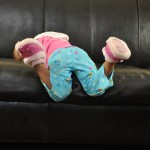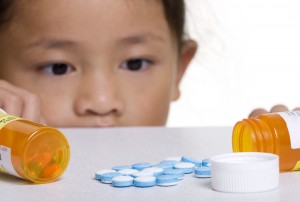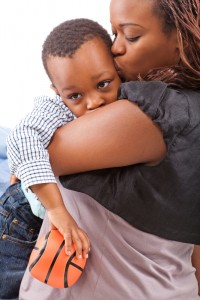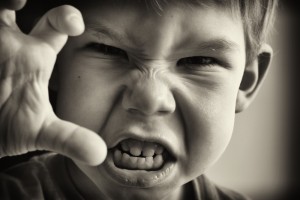
Disruptive behaviour problems (DPB) such as conduct problems or being oppositional and defiant affect a large proportion of young children. For example, one in eleven pre-schoolers may show these behaviours to a degree that would warrant a formal diagnosis of disruptive behaviour disorder. Because these early ‘externalising’ behavioural problems are stable across time, and eventually come to predict negative outcomes such as future criminal behaviour, dysfunctional families and psychiatric problems, intervening early is crucial.
While this need for effective early interventions is well recognised, it appears that in recent years, psychotropic medication is being used more and more for outpatient care of these problems. The authors note an increasing use of antipsychotic medication, medication used primarily to treat psychotic symptoms (delusions, hallucinations, disordered thought). This is worrying because:

We know very little about the safety and efficacy of antipsychotics as a treatment for early child disruptive behaviour
- There have been no well-controlled evaluations on the effectiveness of using antipsychotics on early child disruptive behaviour and
- There may be potential side effects of taking these medications on metabolic, endocrine and cardiovascular functioning.
In contrast, the use of psychosocial treatments, despite being the recommended ‘first line’ treatment for young children with DPB has significantly decreased in recent years.
In light of these trends, this paper (Comer et al, 2013) sets out:
- To investigate the overall effectiveness of psychosocial treatments on early DPB, by pooling results across a number of similar studies using meta-analysis procedures, and
- To explore ‘moderators’ of these effects, that is, variables that might increase/decrease treatment effectiveness or individual characteristics that might make these treatments more or less effective.
Methods
Studies published before January 1, 2012 that satisfied seven criteria were included:
- The clinical trial had to intentionally target disruptive behavioural problems (rather than reductions in DPB being an incidental effect of a treatment targeting other clinical problems)
- The mean age of the sample had to be under 8 years, thus choosing to focus on very early DBP
- The study had to have used a between-subjects design, randomly allocating participants to a treatment or controlled comparison condition
- The sample size had to be large enough to afford statistical analyses i.e. five or more subjects per condition
- Quantitative comparisons needed to have been performed
- Enough information had to be provided for the authors to obtain, or compute effect sizes of the comparison between the active treatment condition and the controlled comparison condition
- The study must have undergone critical review by other researchers in the field
Several strategies were used to identify studies; 36 were included in the final meta-analysis. These studies were then coded for study methodology, treatment, and child variables. Coders were ‘‘trained-to-criterion’’ (i.e., they showed 80%or greater reliability on all codings).
Results

Psychosocial treatments had a large effect on early disruptive behaviour problems
Thirty-six studies that evaluated 3,042 children met study criteria and were included in the meta-analysis.
Overall, psychosocial treatments had a large effect on early disruptive behaviour problems (Hedges’ g = 0.82, SE = 0.10, 95% CI = .63–1.01, z = 8.63, p < .0001). This result was highly robust against the file-drawer effect (the probability that unpublished null findings would eliminate the obtained results). However, there was considerable heterogeneity in the magnitude of effects across studies, suggesting that it was important to examine study variables and individual characteristics that might increase or decrease effect sizes.
Breaking down DPBs into different symptom types, general externalising symptoms showed the largest response, followed by oppositionality/noncompliance. Symptoms of impulsivity and hyperactivity showed the weakest treatment response relative to the other symptom classes, although the magnitude of effect on impulsivity/noncompliance still fell in the medium range.
The largest effect sizes were found immediately after the end of treatment than at follow-up evaluations (although the effects of treatments were still very apparent at follow-up, with medium to large effect sizes).
Whereas behavioural treatments collectively demonstrated a large effect on disruptive behavior symptoms, non-behavioural treatments (e.g., family systems approaches, nondirective counselling) demonstrated only small to medium effects. Treatment length did not moderate response. Nor did it matter whether or not treatment was delivered in groups or involved children directly. Treatments showed larger effects in samples of older youth, and with higher percentages of males but were consistent across racial and ethnic groups.
Conclusions

This research supports the view that children with early disruptive behaviour problems should be offered psychosocial treatments before medication
Psychosocial treatment options collectively demonstrate a large and sustained effect on early disruptive behaviour problems, supporting consensus guidelines that these should be used in the first instance before medication.
The largest effects were found for behavioural treatments. These include packages such as:
- Parent–Child Interaction Therapy (PCIT)
- Incredible Years
- Helping the Noncompliant Child
- Triple P–Positive Parenting Program
All of these packages target problem behaviours by re-shaping parenting practices to promote effective and consistent discipline techniques; while using positive feedback to encourage more appropriate behaviours.
Despite the support for these interventions, there appears to be a gap in service provision of these programmes. This may reflect inadequate numbers of professionals with appropriate training. The paper calls for wider dissemination of these programmes but also more inventive methods of delivery that use new technology such as secure video conferencing.
Limitations
These findings are limited in several ways. First, these conclusions are based mainly on behavioural interventions that target parenting behaviours; other psychosocial interventions such as school-based approaches have received little empirical attention but are likely to be an important aspect in the reduction of early DBPs. Second, limited data meant that a number of other important moderators such as comorbidity, parent psychopathology, treatment adherence, and therapist competence could not be investigated. Third, it is possible that the lack of significant effects associated with non-behavioural treatments was due to the smaller proportion of trials (11.1%) that specifically evaluated these.
Link
Comer JS, Chow C, Chan PT, Cooper-Vince C, Wilson LA. Psychosocial treatment efficacy for disruptive behavior problems in very young children: a meta-analytic examination. J Am Acad Child Adolesc Psychiatry. 2013 Jan;52(1):26-36. doi: 10.1016/j.jaac.2012.10.001. Epub 2012 Dec 12. [PubMed abstract]


Can psychosocial treatments be used effectively to treat disruptive behaviour problems in young children?: Dis… http://t.co/ruyCgbNbjF
@Mental_Elf #DisruptiveBehaviour #MoodDisorders defined by #Society NOT REAL! Through time #SocialAcceptance changes #Psyche can be #moulded
@Mental_Elf national commitment on these interventions in Scotland under MHS 2012-15
Children with early disruptive behaviour problems should be offered psychosocial treatments before medication http://t.co/UOYosGMgdo
@Mental_Elf I assumed they already were?
@Mental_Elf there’s a lot to be said for common sense!
Can psychosocial treatments be used to treat disruptive behaviour problems in young children? http://t.co/izHAclZSCL via @sharethis
Great debut blog: Dr Jennifer Lau on psychosocial treatments for disruptive behaviour in young children http://t.co/UOYosGMgdo
Read our blog on ‘Parent–Child Interaction Therapy’ and ‘Incredible Years’ for young children http://t.co/UOYosGMgdo
Read our blog on ‘Helping the Noncompliant Child’ & ‘Triple P–Positive Parenting Program’ for young children http://t.co/UOYosGMgdo
Can psychosocial treatments be used effectively to treat disruptive behaviour problems in young children? – http://t.co/IhVuUjbZzI
Using consistent discipline techniques & positive feedback to encourage appropriate behaviours in children http://t.co/UOYosGMgdo
‘oppositional and defiant’ – sounds familiar! MT @Mental_Elf: discipline & feedback encourage appropriate behaviours http://t.co/m7PP3rSePN
In case you missed it: Psychosocial treatments can be used to treat disruptive behaviour in young children http://t.co/UOYosGMgdo
Can psychosocial treatments be used effectively to treat disruptive behaviour problems in young children? http://t.co/yCB2fa2GNb
#Psychosocial treatment efficacy for #disruptivebehavior problems in very young children: a meta-analysis http://t.co/kln3edyKFY #rvsed
Psychosocial treatment efficacy for #disruptivebehavior in very young children: a meta-analytic http://t.co/kln3edyKFY #rvsed #parenting